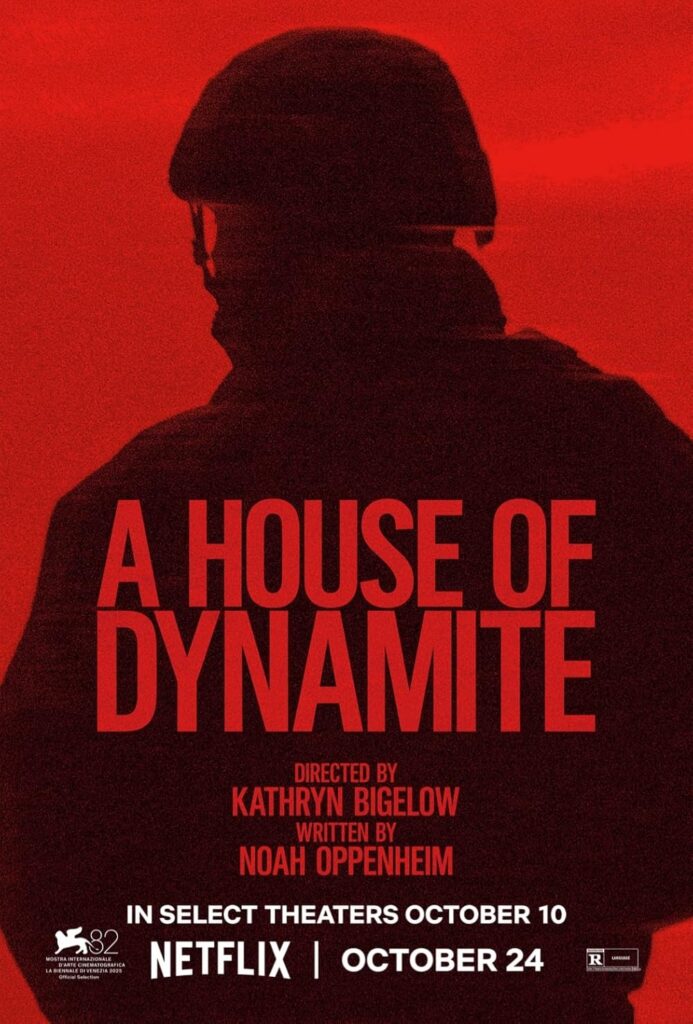A House Of Dynamite
Introduction
It is interesting how Stanley Kubrick’s Dr Strangelove (1964) has formed the basis of so many films like A House Of Dynamite, wherein most parts of the drama takes place in a tense war-room. The latter borrows the basic premise of the former here while flipping it on its head – the victim in this case being the United States Of America that needs to tackle a nuclear bomb headed their way. But the fascinating aspect of A House Of Dynamite remains its serious tone in the first act that consumes you with a bout of tension. As opposed to the bouts of black humour infused in the narrative in Dr Strangelove, the medium employed here is that of tension that could be sliced with a knife – something more on the lines of the film September 5 (2024) that played out mostly in the same vicinity of the room, with similar bouts of tension on display. But at the same time, I couldn’t also help but think of this film to be a progressively depreciating asset, something that would resemble a new car – it would work like a dream initially but would progressively start giving issues as it heads towards its final leg. And that remained a major obstacle in me loving the film and finding it decent!
Story & Screenplay
Written by Noah Oppenheim, A House Of Dynamite gets to a bit of a flyer even as you are acquainted with the character of Captain Olivia Walker (Rebecca Ferguson). In an initial scene, you see her spending fleeting moments with her feverish son, and her husband before heading out for her early morning shift at the White House. She remains an ordinary woman leading a mundane but satisfactory life, even as the fateful day is seemingly like a regular day at work. This, until an unidentified flying object heading towards a major city of the United States, puts the cats among the pigeons.
I liked how the the ambience of the room exuded of a vibe of urgency in the drama, further amplified by a timer that would seemingly keep everyone on their toes. The backdrop of politics plays an important part as well, even as the members of the various teams are shown to carry out different duties delegated to them – from identifying the object as a weapon of mass destruction, while forming a bid to trace its origin and formulate a plan to intercept it along the way. Within this space, the writing does offer moments of humane touch even as a character is seemingly worried about his family member, a potential moment of stillness in the eye of the storm. But what ought to have been the majority of the movie, often wanders into chapters of reboot and the Rashomon effect while flipping the POVs to some of the other characters. And here is where the drama falters.
The Rashomon effect is a powerful narrative tool employed to exercize a psychological edge in the drama, wherein the same situation is viewed differently through the lens of multiple characters. But it is effective only when there is a payoff tagged to it, or alternately when the POV reflects different measures of enhancing the storytelling technique. And why I view this as a squandered opportunity is because the momentum of a seemingly potential nuclear attack as a premise was already set with the existing wave of characters. Switching the POV basically meant on having to stop and reboot, while having to reinvest in a fresh bunch of characters even as the same conflict plays out a couple of more times in the film.
When you are introduced to some of the other characters in the form of the Deputy National Security Advisor Jake (Gabriel Basso) or even the President Of The United States Of America – POTUS (Idris Elba in yet another role of a political figure after Heads Of State), the writing does little to justify the importance of Rashomon through these characters. Yes, the minor conflicts in play add to the tension, just about holding onto the narrative here – Jake is shown to be reluctant with political talks even while making the entire situation a test of temperament for him, just as it is for POTUS who needs to make a decision that would potentially change the history of his nation seething with anger, but the purpose is often drowned in this gimmicky narrative.
And while I did resonate with the larger messaging on what would you do in a similar situation while offering scope to ponder on the actual importance of nuclear weaponry, linking it to that of mass destruction – the open end for me did not quite work either. The definite closure was the need of the hour even with respect to atleast providing hints about the origin of the object given that the Rashomon effect was in play, something that demanded closure while justifying a flip in the POV. But what you get is something quite redundant and repetitive. And so amidst the personal losses, the film did feel slightly abrupt with its ending wherein the ultimate messaging did drown in a sea of gimmicky experimentation.
Dialogues, Music & Direction
The dialogues definitely add to the urgency of the narrative while adding to the tension with respect to the situation faced by the characters. The searing background score does contribute well to the ambience of an intimate setup that surmounts to a psychological impact with regards to the proceedings too. The cinematography also accounts for the psychological quotient of the characters in the midst of a potential catastrophe, wherein the frames do coax you to invest in the characters and their decision-making abilities.
But the biggest letdown for me was the editing pattern here, that loosely divided the narrative into three chapters that often halts, reboots and restarts the narrative every single time. What that did was frequently take me out of the drama and distracting me, both of which weren’t ideal with regards to the intended impact of the drama. Director Kathryn Bigelow is a huge name often equated as the mind behind films like The Hurt Locker (2008) and Zero Dark Thirty (2012). And while she does a fine job in building the tension in the first act, the creative decision to implement the Rashomon effect fizzles out the impact of the drama in the second and third acts. And even when the ending was a brave one, the impact was drowned in this gimmicky narrative that didn’t always command my attention, even as the direction ends up in middling territory.
Performances
The performances are incredibly good and they nearly save the day here. The likes of Greta Lee as Ana, Jason Clarke as Adniral Mark and Anthony Ramos as Major Gonzalez have their moments to shine. Tracy Letts as General Anthony Brady is assertive while putting forth a solid impact. Jared Harris as Baker exhibits an emotional arc that required him to internalize his feelings, and he does that with some flair. Gabriel Basso as Jake does a wonderful job while exploring the traits of hesitation and anxiety thoroughly well. Idris Elba as POTUS is dignified and exudes of a lot of grace with his impeccable performance. Rebecca Ferguson as Olivia remains the best actor on show, being wonderfully well restrained and putting forth a commendable act with varied degrees of calmness in a chaotic situation.
Conclusion
Despite boasting of impeccable performances, A House Of Dynamite is a decent political thriller with a hollow payoff, particularly due to the creative decision to incorporate the Rashomon effect in the narrative that ended up being quite gimmicky in nature. As a result, the drama on the whole also ends up being middling! Available on Netflix.





